Our love for Banggai cardinalfish is almost unconditional at this point - not only are these little beauties easy and an absolute joy to care for, but they sport such a beautiful and unique appearance, making them one of the best saltwater fish to keep in the hobby.
In this guide, we will be covering absolutely everything there is to know about caring for the Banggai cardinalfish in detail based on our first-hand experience with these glorious little fish. We will even be discussing breeding them, if that is something that interests you.
Banggai Cardinalfish: The Complete Overview
It is not just us that have a soft spot for these fish, in fact, they are one of the most popular saltwater fish in the aquarium trade and have been for some years.
We will be covering general care, tank setup, diet, tank mates, lifespan, hardiness, and more throughout this care guide. However, before we do, here is a detailed overview of the Banggai cardinalfish and its various parameters in both graphical form and bullet points below:
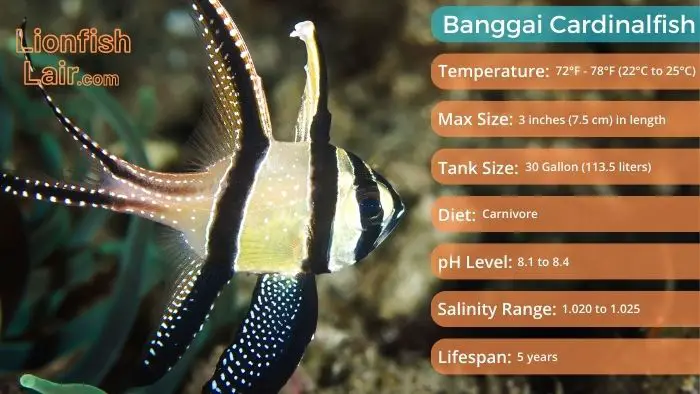
- Appearance: Small in size, sporting a silver body with dark black stripes and white and black spotted fins and tail.
- Behavior: Peaceful fish, getting along well with most other fish of a peaceful nature (keep reading to find out more about tank mates and compatibility with other fish).
- Habitat: Require shallow saltwater reef systems, preferably with seagrass beds to thrive in both captivity and in the wild (not essential in captivity).
- Scientific name: Pterapogon kauderni
- Lifespan: A maximum of 5 years.
- Hardiness: Extremely hardy fish.
- Care level: Beginner compatible.
- Maximum size: 3.5 inches (8.89 cm) in length.
- Temperature range: 72 to 82°F (22.2 to 27.7°C).
- Minimum tank size: 30 gallons (136.3 liters).
- pH range: 8.1 to 8.4.
- Diet: Carnivore.
Banggai Cardinalfish General Information
Native to Indonesia, and more specifically the shallow and tranquil reefs and seagrass beds of the Banggai Archipelago, Banggai cardinalfish are small, schooling carnivorous fish that, for the most part, enjoy the company of their own inside and out of an aquarium environment.
This stunning fish has quickly become one of the most popular saltwater fish species to care for, and we hope to show you why!
This section will be covering information surrounding the cardinalfish Banggai, discussing their appearance, size, and behavior in detail.
Banggai Cardinalfish Appearance
Banggai cardinalfish is a ray-finned saltwater fish, which has a total of 8 dorsal spines, 14 dorsal rays, 2 anal spines, and 13 anal soft rays!
The most significant aspects of their appearance have to be the tasseled dorsal fin and the branched caudal fin, whilst both the second dorsal fin and anal fin rays are elongated.
Their coloration is the next stand out - they sport 3 deep-black lines that cover the head and body, with black edges covering the outskirts of their second dorsal and anal fins, and black pelvic fins that are covered in tiny white spots.

The body is a shiny silver color, including around 20 white spots that reside between the second and third black stripes.
Banggai Cardinalfish Size
They are pretty small fish in size and stature, which is one of the many reasons why they are compatible for beginners with small tanks.
Typically, the Banggai cardinalfish will grow to a maximum length of 3.5 inches (8.89 cm).
However, this size can only be achieved if they are living a healthy life, and all of their specific tank requirements have been met! Below is a graphical summary of their size, including height and length:
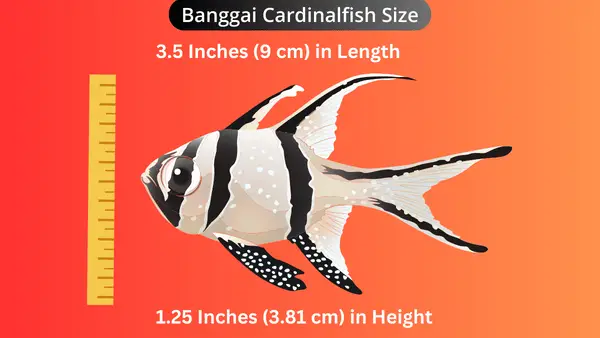
Banggai Cardinalfish Behavior
From our own experiences with Banggai cardinals, they are peaceful and do enjoy the company of their own in an aquarium space. However, other hobbyists have had different experiences with keeping them in groups of their own.
Typically, they are peaceful fish, but they can be semi-aggressive and somewhat territorial.
It is usually just down to luck with how aggressive your fish turn out to be, but you can certainly influence this by providing them with the best setup and most stress-free life by ensuring they are residing with compatible tank mates.
Banggai cardinalfish is the only member of the Apogonidae family that are active during the day, which is obviously ideal for keeping them in your home saltwater fish tank.
Our advice is not to keep them in super large groups of their own kind, but you should certainly keep them in smaller groups.
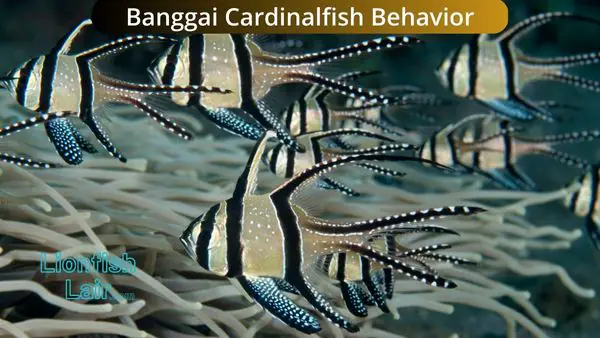
Keep reading to learn more about their behavior with other fish in our Banggai cardinalfish tank mates section!
Banggai Cardinalfish Price
The price of Banggai cardinals tends to vary from store to store. However, generally speaking, they are usually around $20-$28 for a singular fish, $30-$50 per pair, and can range from anywhere between $78 to $100 for a group.
It is important before you make your purchase to conduct thorough checks, ensuring that the fish are not injured nor carrying any unwanted diseases!
How Long does a Banggai Cardinalfish Live For?
This really depends on how well their tank has been set up and also how much stress they are under. Stress is one of the biggest killers of fish, solely because it leads to disease and anti-social behavior.
If your Banggai cardinalfish tank setup has been performed correctly and you keep on top of the maintenance, whilst providing them with plenty of hiding spots and compatible tank mates to reduce stress, they can live as long as 5 years.
Alternatively, if you do not follow the correct setup and introduce incompatible tank mates to their homes, they can die extremely prematurely! This is why tank setup and tank mates are so important to get right.
Also of note is that Banggai cardinalfish are very hardy fish, in fact, they even feature on our list of the hardiest saltwater fish and can tolerate fairly large ranges of water temperatures and pH levels without falling sick.
The following section of this guide will cover everything you need to know about their tank setup.
Banggai Cardinalfish Tank Setup
When it comes to Banggai cardinalfish care, nothing is more important than their tank setup. Water temperature, pH level, salinity, tank size, tank mates, amount of fish, and filtration are what we will be covering in this section.
Water Parameters for the Cardinalfish Banggai
Ideally, you will need to keep their water temperature between 72°F and 78°F which equates to 22.2°C to 25.5°C, if you work in Celsius.
Their hardiness allows them to handle a wider range of water temperatures, however, you must ensure that you do not let the temperature drop below or surpass these ranges.
The graphical summary below showcases the Banggai cardinalfish's water requirements:

The pH level in their tank should always be between 8.1 and 8.4, no more, no less. Equally, you must keep the water hardness between 1.020 and 1.025.
A good tank filter is needed, and the water movement should be brisk to provide them with a realistic environment. Ammonia levels must also be 0 and the same applies to nitrate!
This goes without saying, but constant and consistent water changes are required to keep them healthy and ultimately, happy.
Ideal Banggai Cardinal Tank Size and Decorations
Depending on the amount you plan to keep will depend on the size of the tank you keep them in! I know, pretty hard to imagine, right?
Well, we recommend keeping a singular or pair in a 30-gallon (113.5 liters) tank as a minimum size due to them needing space to swim and places to hide - banggai cardinals are the perfect 30 gallon saltwater fish.
If you are experienced enough to keep a small group, say 3 to 5 Banggai cardinalfish, you should keep them in a reef tank environment with a minimum tank size of 50 gallons (189.2 liters).
Below is a graphical summary of a 30-gallon tank with the most common ideal tank dimensions (36" x 18" x 16") and weight (empty: 48 lbs. filled: 348 lbs.) for one to two Banggai cardinals:

Creating a reef-like environment is pretty essential for you to get the most out of your Banggai cardinal. This mimics their natural environment whilst also providing them with plenty of hiding spots, which is calming for them.
Below is the ideal environment for them to reside in:

How Many Banggai Cardinalfish Can Live Together?
This topic is super interesting and has sparked plenty of debate amongst Banggai cardinalfish owners. To us, this is simple - if you own a big enough tank with a large area for your fish to swim around happily and safely, with hiding spots, then you can keep a maximum group of 5.
There are some instances where groups of cardinals will end up fighting each other over territory and food. However, if you purchase them at the same time, from the same place, this will reduce the risk tremendously.
Of course, you can keep a single Banggai cardinalfish, and this is certainly recommended if you are a beginner fish keeper, with a small tank and little experience. Equally, you can keep a pair of Banggai cardinals too, and should certainly do this if you want a mated pair.
Banggai Cardinalfish Tank Mates
Banggai cardinals are small and overall very peaceful fish - they are compatible with the majority of peaceful saltwater fish that share a similar size and the same tank requirements.
Compatible Banggai Cardinalfish Tank Mates
Here are the most compatible and best Banggai cardinalfish tank mates that will complement them extremely well:
- Dwarf angelfish.
- Clownfish.
- Reef safe wrasses.
- Pufferfish.
- Chromis fish.
- Basslets and Grammas.
- Tangs/Surgeonfish.
- Gobies.
As you can see - they are compatible with a whole bunch of wonderful saltwater fish, and as you can see from the image below, these fish sport some awesome and unique colors and patterns:
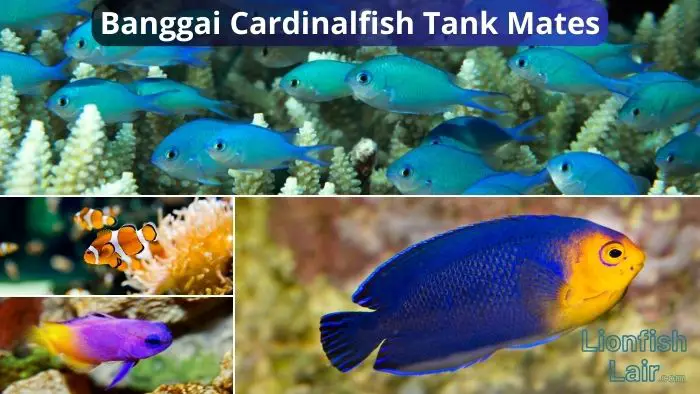
A favorite pairing of ours is the clownfish and banggai cardinalfish combination - due to their similarities in size and behavior, they suit each other very well. Also, they look totally different from each other, which is a cool visual.
Banggai cardinals are also compatible with live corals as they will not destroy them, nor pick at them. They can live with saltwater invertebrates too and will not bother them.
Incompatible Banggai Cardinalfish Tank Mates
Now that we have discussed the compatible tank mates, here are some incompatible tank mates that we urge you to stay away from keeping with the Banggai cardinalfish:
- Anglerfish & Frogfish.
- Eels.
- Goatfish.
- Groupers.
- Dwarf Lionfish.
- Lionfish.
- Seahorse/Pipefish.
- Sharks/Rays.
- Triggerfish.
Unfortunately, due to the predatory nature of the fish above, they will make short work of Banggai cardinalfish if kept in the same tank, or just bully them until they eventually die from stress.
Banggai Cardinalfish Diet
Banggai cardinalfish, unlike most other saltwater fish of their size, are actually carnivores, feeding on meat-based foods. Regardless of this, you should be feeding them a balanced diet and varying their meals.
What is the Best Food for Banggai Cardinalfish?
Feeding them a balanced and varied diet is key - we recommend brine shrimp, Mysis shrimp, bloodworms, and clam meat in both frozen and dried forms.
Nutrient-rich carnivore pellets and flakes should also be added to their diet to mix things up. As a special treat, you should add live forms of the food mentioned above as it releases their natural instincts when hunting food in the wild.

How Often Should You Feed Them?
Some say to feed them as much as three times a day. However, from our own experience, twice is plenty, and you could even feed them once per day if you add enough food to the feed.
Just be careful that other tank inhabitants do not steal their food - this can happen a lot!
Twice is sufficient, and we recommend doing so once in the morning and once at night, when you start to dim your aquarium lights to resemble nighttime.
Banggai Cardinalfish Spawning (Breeding)
The spawning/breeding cycle of Banggai cardinalfish is as unique as their appearance! Firstly, you need to ensure you have a pair of cardinals that are both male and female.
How to tell the Difference Between Males and Females?
It is virtually impossible to tell the difference between both male and female Banggai cardinalfish, that is if you do not know what to look out for.
The best way to find out whether you have a male or female is by looking at the underside of the fish. Just in front of their bottom fin, you will see a small vent, almost minuscule in size.
They can be mistaken for bumps, or a weird parasite-type thing, but they are not, and this is your key to identifying the sex of your Banggai cardinal.
A male has two of these vents and a female has one! Take a super close look and you will see them. Below is an image highlighting these exact vents:
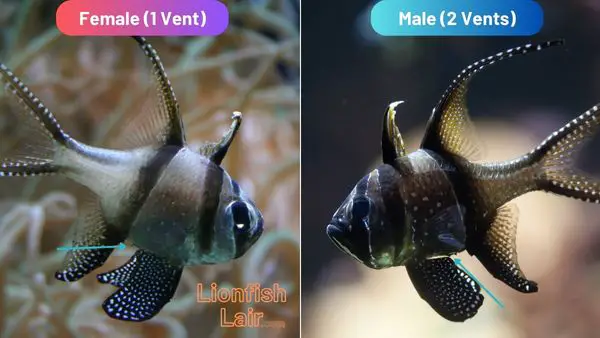
How do they Spawn/Breed?
Cardinalfish are mouthbrooders, which means that when they spawn, the female will lay a clutch of eggs in the open water, the male will fertilize them and then suck the eggs into his mouth!
It is super easy to identify a male banggai cardinal carrying eggs as his mouth will be full of marble-looking eggs! Their mouth shape changes and they look like they are storing food in there.
After roughly three weeks, you can expect to see banggai cardinalfish fry swimming around your tank, they are pretty good eaters too, accepting newly hatched shrimp and also larvae pellets.
It is key that you bear in mind - breeding fish is for experienced fishkeepers, as you will more than likely have to keep the fry in a separate tank to give them the best chance of survival!
Banggai Cardinalfish Care - Final Thoughts (Endangered Species)
We hope you have found this guide useful and can use our tips and information to create a harmonious and peaceful banggai cardinalfish aquarium or introduce them to an already thriving reef environment!
These fish hold a special place in our hearts and with the right care and guidance, they hopefully will for you too. Just ensure that you follow our guide and tank setup, and you too will own a happy and healthy banggai cardinalfish for the foreseeable future.
Unfortunately, the beautiful banggai cardinalfish has become endangered in the wild, making the IUCN Redlist, being threatened under the Endangered Species Act.
Thanks to the efforts of marine conservationists around the world, one of our favorite fish will return to its former glory!

